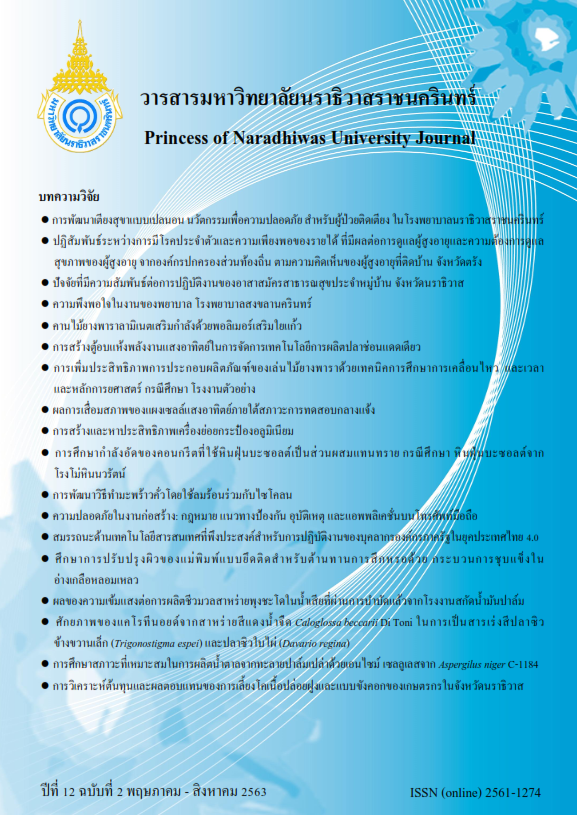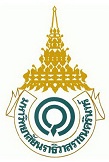การศึกษากำลังอัดของคอนกรีตที่ใช้หินฝุ่นบะซอลต์เป็นส่วนผสมแทนทราย กรณีศึกษา หินฝุ่นบะซอลต์จากโรงโม่หินนวรัตน์
คำสำคัญ:
หินฝุ่นบะซอลต์, ทราย, คอนกรีต, กำลังอัดบทคัดย่อ
งานวิจัยนี้มีวัตถุประสงค์เพื่อศึกษากำลังอัดของคอนกรีตที่ใช้ฝุ่นบะซอลต์เป็นส่วนผสมแทนทราย กรณีศึกษาหินฝุ่นบะซอลต์จากโรงโม่หินนวรัตน์ รวมไปถึงการศึกษาการประยุกต์ใช้ในงานวิศวกรรมโยธา ทั้งนี้จะใช้หินฝุ่นบะซอลต์เป็นส่วนผสมแทนทรายที่อัตราส่วนร้อยละ 0 20 40 60 80และ 100 (แทนทรายทั้งหมด) โดยน้ำหนัก การผสมคอนกรีตใช้อัตราส่วน 1:2:4 (ปูนซีเมนต์:ทราย:หิน) โดยน้ำหนัก ที่อัตราส่วนน้ำต่อปูนซีเมนต์ (W/C) เท่ากับ 0.55 ค่าการยุบตัวของคอนกรีต (Slump) ที่ผสมหินฝุ่นบะซอลต์ อยู่ในช่วง 7.0 - 8.5 ซม. ทั้งนี้ปรากฏว่าการรับกำลังอัดของคอนกรีต เมื่ออายุการบ่มน้ำ 28 วัน ของแต่ละอัตราส่วนผสมที่ใช้ฝุ่นบะซอลต์แทนทราย มีค่าแตกต่างกันอยู่ในช่วง 173 - 229 กก./ตร.ซม. (หรือเฉลี่ย 200 กก./ตร.ซม.) โดยคอนกรีตที่ใช้หินฝุ่นบะซอลต์เป็นส่วนผสมแทนทราย ที่อัตราส่วนร้อยละ 80 โดยน้ำหนักได้ให้ค่ากำลังอัดเฉลี่ยสูงสุดที่ 229 ± 2.90 กก./ตร.ซม. ทั้งนี้เมื่อเปรียบเทียบค่ากำลังอัดเฉลี่ยสูงสุดนี้ กับค่ากำลังอัดเฉลี่ยของคอนกรีตที่ผสมตามปกติ ที่มีค่ากำลังอัด 272 กก./ตร.ซม. จะเห็นว่าคอนกรีตปกติมีค่ากำลังอัดสูงกว่าประมาณ 15.8% ในส่วนของการประยุกต์ใช้ หากพิจารณามาตรฐาน มยพ.1101-52 ของกรมโยธาธิการและผังเมือง ที่กำหนดค่ากำลังอัดประลัยต่ำสุด ที่ 150 180 210 และ 240 กก./ตร.ซม.สำหรับคอนกรีตประเภท ค1 (งานก่อสร้างทั่วไป) ค2ค3 และ ค4 พบว่า คอนกรีตที่ผสมหินฝุ่นบะซอลต์แทนทรายทุกอัตราส่วนร้อยละ ให้ค่ากำลังอัดอยู่ในเกณฑ์มาตรฐาน และมีศักยภาพสูงที่จะประยุกต์ใช้ในงานก่อสร้างทางโยธาด้านต่าง ๆ
References
Al-Rawashdeh, M. & Shaqadan, A. (2015) Effect of basalt aggregates and plasticizer on the compressive strength of concrete. International Journal of Engineering & Technology. 4(4), 520-525. Science Publishing Corporation.
ASTM C70-20. (2020). Standard Test Method for Surface Moisture in Fine Aggregate, ASTM International, West Conshohocken, PA.
ASTM C136/C136M-19. (2019). Standard Test Method for Sieve Analysis of Fine and Coarse Aggregates, ASTM International, West Conshohocken, PA.
ASTM C127-15. (2015). Standard Test Method for Relative Density (Specific Gravity) and Absorption of Coarse Aggregate, ASTM International, West Conshohocken, PA.
ASTM C128-15. (2015). Standard Test Method for Relative Density (Specific Gravity) and Absorption of Fine Aggregate, ASTM International, West Conshohocken, PA.
ASTM C29/C29M-17a. (2017). Standard Test Method for Bulk Density (Unit Weight) and Voids in Aggregate, ASTM International, West Conshohocken, PA.
ASTM C143 C143M-15a. (2015). Standard Test Method for Slump of Hydraulic-Cement Concrete, ASTM International, West Conshohocken, PA.
ASTM C192/C192M-19. (2019). Standard Practice for Making and Curing Concrete Test Specimens in the Laboratory, ASTM International, West Conshohocken, PA.
ASTM C39/C39M-20. (2020). Standard Test Method for Compressive Strength of Cylindrical Concrete Specimens, ASTM International, West Conshohocken, PA.
Blyth, F.G.H. & Freitas de, M.H. (2006) A Geology for Engineers. (5th Ed.). CRC Press. Chovichian, V. (2001). Concrete Technology. Bangkok: P. Sampanpanich. (In Thai).
Farndon, J. (2006). The Complete Guide to Rocks & Minerals. Anness Publishing Ltd. http://www.knc2001.com /files/knc2001.pdf.
Kingkaew, R., Chaijit, P., Chotchuay, V. & Chaihan, J. (2015). The Substitution of Sand by Stonedust in Ready Mixed Concrete. Journal of Southern Technology. 8(2), 55-61.
Komenthammasopon, S. (2012). The Investigation of Compressive Strength of Concrete in Case Study using Granite Dust from Thai Crushing Plant as Replacement for Sand. Princess of Naradhiwas University Journal. 4(3), 44-53.
Komenthammasopon, S. (2013). The Investigation of Compressive Strength of Concrete in Case Study using Sieved Granite Dust from Thai Crushing Plant as Replacement for Sand. Princess of Naradhiwas University Journal. 5(1), 49-60.
Leroy, M.N., Guy Molay T.G., Joseph N., Colince, F.M. & Bienvenu J.N. (2017). A Comparative study of concrete using metamorphic, igneous, and sedimentary rocks (crushed gneiss, crushed basalt, alluvial sand) as fine aggregate. Journal of Architectural Engineering Technology, 6(1), 1-6.
Nijanpansri, P. (2005). Research report on the use of dust aggregate as sand replacement. National Research Council of Thailand. (In Thai).
Nokkaew, N. (2015). Highway Engineering. (5th Ed.) Faculty of Engineering, Rajamangala University of Technology Thanyaburi. (In Thai).
Standard of the Department of Public (2020) Works and Town & City Planning (DPT) 1101-52. Retrived 13 January 2020 from: http://www.dpt.go.th
Suresh, N., & Manjunatha M. (2016). Effect of different types of fine aggregates on mechanical properties of concrete – A review. The Indian Concrete Journal, 69-71.
Suwansukroj, N., Pansaengdao, T. & Termsak, S. (1998). Compressive Strength of Concrete Composed of Crushed Dust Instead of Sand. KKU Engineering Journal. 25(2), 1-5.
Ukpata, O.J., Ephraim, E.M. & Akeke A.G. (2012). Compressive strength of concrete using lateritic sand and quarry dust as fine aggregate. APRN Journal of Engineering and Applied Sciences, 7(1), 81-92.
West, R.T. (2010). Geology Applied to Engineering. Waveland Press, Inc.



